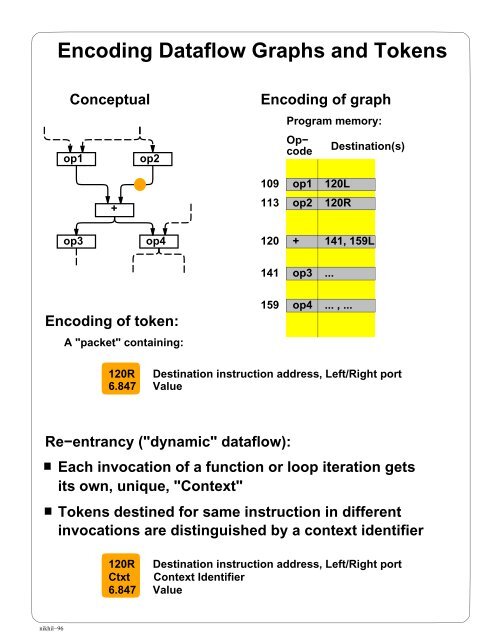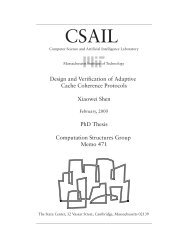additional slides - MIT
additional slides - MIT
additional slides - MIT
You also want an ePaper? Increase the reach of your titles
YUMPU automatically turns print PDFs into web optimized ePapers that Google loves.
nikhil−96<br />
Encoding Dataflow Graphs and Tokens<br />
Conceptual Encoding of graph<br />
op1 op2<br />
+<br />
op3 op4<br />
Encoding of token:<br />
A "packet" containing:<br />
109<br />
113<br />
120<br />
141<br />
159<br />
Program memory:<br />
op1<br />
op2<br />
+<br />
op3<br />
op4<br />
Destination(s)<br />
120R Destination instruction address, Left/Right port<br />
6.847 Value<br />
Re−entrancy ("dynamic" dataflow):<br />
Op−<br />
code<br />
120L<br />
120R<br />
141, 159L<br />
... , ...<br />
Each invocation of a function or loop iteration gets<br />
its own, unique, "Context"<br />
Tokens destined for same instruction in different<br />
invocations are distinguished by a context identifier<br />
120R Destination instruction address, Left/Right port<br />
Ctxt Context Identifier<br />
6.847 Value<br />
...
<strong>MIT</strong> Tagged Token Dataflow Architecture<br />
nikhil−97<br />
Designed by Arvind et. al., <strong>MIT</strong>, early 1980’s<br />
Simulated; never built<br />
Global view:<br />
Processor Nodes<br />
(including local program and "stack" memory)<br />
Interconnection Network<br />
"I−Structure" Memory Nodes (global heap data memory)<br />
Resource Manager Nodes responsible for<br />
Resource<br />
Manager<br />
Nodes<br />
Function allocation (allocation of context identifiers)<br />
Heap allocation<br />
etc.<br />
Stack memory and heap memory: globally addressed
<strong>MIT</strong> Tagged Token Dataflow Architecture<br />
Processor<br />
nikhil−98<br />
Token<br />
Queue<br />
To network<br />
Wait−Match Unit:<br />
Wait−Match<br />
Unit<br />
Instruction<br />
Fetch<br />
Execute<br />
Op<br />
Form<br />
Tokens<br />
From network<br />
Waiting token<br />
memory (associative)<br />
Program<br />
memory<br />
Tokens for unary ops go straight through<br />
Tokens for binary ops: try to match incoming token<br />
and a waiting token with same instruction address<br />
and context id<br />
Success:<br />
Fail:<br />
Output<br />
Both tokens forwarded<br />
Incoming token −−> Waiting Token Mem,<br />
Bubble (no−op) forwarded
<strong>MIT</strong> Tagged Token Dataflow Architecture<br />
Processor Operation<br />
nikhil−99<br />
Token<br />
Queue<br />
120R,c, 6.847<br />
Wait−Match<br />
Unit<br />
Instruction<br />
Fetch<br />
141,159L,c, +,6.001,6.847<br />
To network<br />
120,c, 6.001,6.847<br />
Execute<br />
Op<br />
141,159L,c, 12.848<br />
Form<br />
Tokens<br />
141,c, 12.848<br />
159L,c, 12.848<br />
Output<br />
Output Unit routes tokens:<br />
From network<br />
Back to local Token Queue<br />
To another Processor<br />
To heap memory<br />
based on the addresses on the token<br />
Waiting token<br />
memory (associative)<br />
120L,c, 6.001<br />
Program<br />
memory<br />
120 + 141, 159L<br />
Tokens from network are placed in Token Queue
<strong>MIT</strong> Tagged Token Dataflow Architecture<br />
Support for "Remote Loads"<br />
nikhil−100<br />
Conceptual:<br />
A<br />
Fetch<br />
v<br />
op1<br />
Encoding of graph:<br />
Program memory:<br />
200<br />
Opcode Destination(s)<br />
Fetch<br />
207 op1<br />
Heap Memory<br />
207<br />
...<br />
A v
<strong>MIT</strong> Tagged Token Dataflow Architecture<br />
Support for "Remote Loads"<br />
nikhil−101<br />
Token<br />
Queue<br />
207,c, v<br />
200,c, A<br />
Fetch, A, 207,c<br />
Fetch, A, 207,c<br />
Wait−Match<br />
Unit<br />
200,c, A<br />
Instruction<br />
Fetch<br />
207,c, Fetch,A<br />
Execute<br />
Op<br />
Fetch,A, 207,c<br />
Form<br />
Tokens<br />
Fetch, A, 207,c<br />
Output<br />
Network<br />
Heap Memory Module<br />
Containing Address A<br />
207,c, v<br />
207,c, v<br />
A v<br />
Multiple remote loads are no problem:<br />
Waiting token<br />
memory (associative)<br />
Program<br />
memory<br />
200 Fetch 207<br />
Can be issued in parallel<br />
"Join" of responses is implicit in Wait−Match
<strong>MIT</strong> Tagged Token Dataflow Architecture<br />
Support for "Synchronizing Loads"<br />
nikhil−102<br />
Heap memory locations have FULL/EMPTY bits<br />
When "I−Fetch" request arrives (instead of "Fetch"),<br />
if the heap location is EMPTY, heap memory module<br />
queues request at that location<br />
Later, when "I−Store" arrives, pending requests are<br />
discharged<br />
"I−structure semantics"<br />
Note: no busy waiting, no extra messages<br />
I−Store,A,v, 191,c2<br />
I−Fetch,A, 207,c<br />
I−Fetch,A, 900,c1<br />
Heap Memory Module<br />
Containing Address A<br />
207,c, v<br />
A E Nil A E<br />
A F v<br />
207,c<br />
900,c1<br />
191,c2, ack<br />
900,c1, v
nikhil−180<br />
Unification of Dataflow & von Neumann<br />
Designs<br />
pure Dataflow<br />
Static<br />
(Dennis &<br />
Misunas ’74)<br />
Argument<br />
Fetching<br />
(Gao,<br />
et. al. 88)<br />
"Static"<br />
(Dennis 91)<br />
Manchester<br />
Dataflow<br />
(Gurd &<br />
Watson 82)<br />
Sigma−1<br />
(Shimada &<br />
Hiraki 87)<br />
Epsilon<br />
(Grafe<br />
et.al. 88)<br />
Epsilon 2<br />
(Grafe &<br />
Hoch 89)<br />
EM 5<br />
(Kodama<br />
& Sakai 91)<br />
TTDA<br />
(Arvind<br />
et.al. 80−83)<br />
Monsoon<br />
(Papadopoulos<br />
& Culler 88)<br />
EM 4<br />
(Sakai 89)<br />
Monsoon<br />
Threads<br />
(Traub &<br />
Papadopoulos<br />
91)<br />
Unified<br />
Hybrid<br />
(Buehrer &<br />
Ekanadham 87)<br />
VNDF<br />
Hybrid<br />
(Iannucci 88)<br />
P−RISC<br />
(Nikhil &<br />
Arvind 88)<br />
Hybrid<br />
*T<br />
multithreaded<br />
von Neumann<br />
TAM<br />
CDC 6600<br />
MASA<br />
(Halstead &<br />
Fujita 88)<br />
EMPIRE<br />
(Iannucci<br />
et. al. 89−91)<br />
(Culler,<br />
et. al. 90)<br />
(Nikhil,<br />
Papadopoulos,<br />
Arvind &<br />
Greiner 91)<br />
1964<br />
HEP<br />
(B.Smith 78)<br />
iPSCs,<br />
CM−5<br />
Horizon<br />
Tera<br />
(B.Smith,<br />
et.al. 88−93)<br />
Alewife<br />
(Agarwal 89)<br />
Message<br />
Passing<br />
Cosmic<br />
Cube<br />
(Seitz 85)<br />
J−Machine<br />
(Dally 87)<br />
(adapted<br />
from a slide<br />
by Greg<br />
Papadopoulos)
















